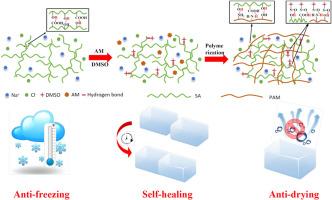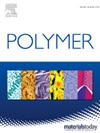制备和应用聚丙烯酰胺/海藻酸钠/二甲基亚砜有机水凝胶,增强抗干燥、抗冻和自愈性能
IF 4.1
2区 化学
Q2 POLYMER SCIENCE
引用次数: 0
摘要
双网络水凝胶由两个不对称结构的交联网络组成,具有优异的机械性能,在柔性传感器领域具有巨大的应用潜力。然而,传统的水凝胶主要以水为介质分散,在自然环境中会不断失去水分,无法长时间保持水合状态,不适合在低温条件下使用。在这项研究中,我们设计了一种基于聚丙烯酰胺(PAM)、海藻酸钠(SA)和二甲基亚砜(DMSO)的有机水凝胶。通过 DMSO 分子、聚丙烯酰胺和海藻酸钠之间的氢键相互作用,这种有机水凝胶不仅具有抗干燥和抗冻性能,而且还具有自愈合特性。此外,这种有机水凝胶还具有出色的机械性能和导电能力,适合用于构建柔性应变传感器,以监测手指弯曲、肘关节弯曲、膝关节弯曲和踝关节伸展等人体运动。此外,这种传感器还具有出色的稳定性和耐用性。本文章由计算机程序翻译,如有差异,请以英文原文为准。


Preparation and application of organic hydrogels incorporating polyacrylamide/sodium alginate/DMSO for enhanced anti-drying, anti-freezing, and self-healing properties
The double-network hydrogel comprises two asymmetrically structured cross-linked networks, demonstrating exceptional mechanical properties and possessing significant potential for application in the field of flexible sensors. However, conventional hydrogels primarily disperse in water as a medium and continuously lose moisture in natural environments, rendering them incapable of retaining hydration over extended periods and unsuitable for utilization under low-temperature conditions. In this study, we devised an organic hydrogel based on polyacrylamide (PAM), sodium alginate (SA), and dimethyl sulfoxide (DMSO). Through hydrogen bonding interactions among DMSO molecules, polyacrylamide, and sodium alginate, this organic hydrogel not only exhibits anti-drying and anti-freezing properties but also demonstrates self-healing characteristics. Moreover, the organic hydrogel showcases remarkable mechanical properties and conductivity capabilities that render it suitable for constructing flexible strain sensors to monitor human movements such as finger bending, elbow flexion, knee joint bending, and ankle extension. Additionally, the sensor exhibits excellent stability and durability.
求助全文
通过发布文献求助,成功后即可免费获取论文全文。
去求助
来源期刊

Polymer
化学-高分子科学
CiteScore
7.90
自引率
8.70%
发文量
959
审稿时长
32 days
期刊介绍:
Polymer is an interdisciplinary journal dedicated to publishing innovative and significant advances in Polymer Physics, Chemistry and Technology. We welcome submissions on polymer hybrids, nanocomposites, characterisation and self-assembly. Polymer also publishes work on the technological application of polymers in energy and optoelectronics.
The main scope is covered but not limited to the following core areas:
Polymer Materials
Nanocomposites and hybrid nanomaterials
Polymer blends, films, fibres, networks and porous materials
Physical Characterization
Characterisation, modelling and simulation* of molecular and materials properties in bulk, solution, and thin films
Polymer Engineering
Advanced multiscale processing methods
Polymer Synthesis, Modification and Self-assembly
Including designer polymer architectures, mechanisms and kinetics, and supramolecular polymerization
Technological Applications
Polymers for energy generation and storage
Polymer membranes for separation technology
Polymers for opto- and microelectronics.
 求助内容:
求助内容: 应助结果提醒方式:
应助结果提醒方式:


